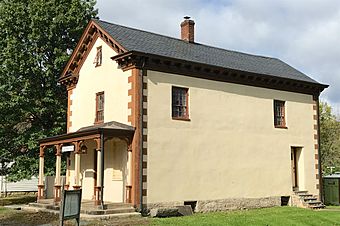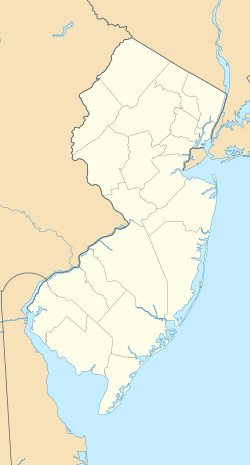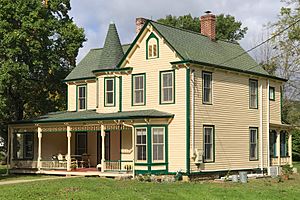King Store and Homestead facts for kids
|
King Store and Homestead
|
|
|
U.S. Historic district
Contributing property |
|

King Store at 211 Main Street
|
|
| Location | 209 and 211 Main Street Ledgewood, New Jersey |
|---|---|
| Built | 1815 |
| Architect | Woodruff & Hopkins |
| Architectural style | Queen Anne, Greek Revival |
| Part of | Ledgewood Historic District (ID13000202) |
| NRHP reference No. | 94000393 |
Quick facts for kids Significant dates |
|
| Added to NRHP | April 29, 1994 |
| Designated CP | April 18, 2013 |
The King Store and Homestead are two important old buildings. They are located at 209 and 211 Main Street in Ledgewood, New Jersey. Ledgewood is a part of Roxbury Township in Morris County, New Jersey, United States.
These buildings are owned by Roxbury Township. The Roxbury Historic Trust helps take care of them. They were bought using special money called Green Acres funding. The buildings were added to the National Register of Historic Places on April 29, 1994. This was because they were very important for business from 1815 to 1928. Later, on April 18, 2013, both buildings also became part of the Ledgewood Historic District.
The King Store's History
The King Store is a two-and-a-half story building. It was built in 1815 by Woodruff and Hopkins. The walls on the ground floor are very thick, about 3 feet (0.91 m). When it was first built, the store had white stucco walls. It also had green shutters and a green door.
The Woodruff family ran the store until 1835. For about two years after that, the building was empty. In 1837, Albert Riggs bought the store. He was the son of Silas Riggs, who worked with leather and owned several canal boats. Albert Riggs reopened the building as a general store. It served the local community and people who used the Morris Canal. For many years, the store also worked as the local Post Office. Its owner was the Postmaster, who managed the mail. The store was located very close to the Morris Canal Basin, about 150 feet away.
Theodore King took over the store in 1873. He was Albert Riggs' son-in-law. Theodore King lived on the second floor of the building with his wife and daughter. By 1881, Mr. King had built a house next door. Then he started to update the store. He changed its look to a Greek Revival style. The new colors were cream with brown trim. The outside walls were given a smooth coat of stucco. This stucco was marked to look like large stone blocks. The inside of the store was also updated. It was given an Italianate design with cream and maroon colors. The Roxbury Rotary group helped fix and make the building strong again by early 2000. After that, they started working on the Homestead.
Architecture of the King Homestead
The King Homestead started as a simple frame house. Over time, it had several parts added to it. These additions had details from the Italianate and Queen Anne styles. The original house might have only included the current parlor and two exhibit rooms. It also had one or both staircases to the second floor. On the second floor, there were two front bedrooms and a smaller bedroom at the back.
There were stairs leading to the basement. The kitchen was in the basement, which was common in homes from the Victorian era. A dumbwaiter was likely moved when the dining room was added. This allowed food to be brought up easily from the kitchen below. The last parts added to the home were probably a round office on the first floor. Mr. King used this office, and later his daughter Louise King used it. A kitchen was also added at the back of the first floor.
One special artistic feature is the dining room mural. It is an oil painting on canvas that covers all four walls. James William Marland painted it in 1936. He signed and dated his work.
Visiting the Museums
Both the King Store and Homestead are now museums. They are open to visitors on the second Sunday of each month. They are closed in January. The museums are open from 1 PM to 4 PM. Visitors are always welcome. If these times don't work for you, you can call to make a special appointment.
See also





